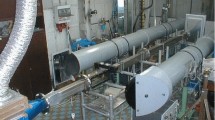Abstract
In a number of industrial facilities and factory buildings dust layers cover floors, walls, ceilings and various installations. The dust can be easily dispersed by pressure waves generated by weak explosions or as a result of damage of a compressed gas systems. If the obtained explosive dust-air mixture is ignited, a devastating explosion may occur. The aim of the work was to study the dust lifting process from the layer behind the propagating shock wave and to determine some important parameters, which later could be used for development and validation of the numerical model of the process. The experiments were conducted with the use of a shock tube. For measuring the dust concentration in the mixture with air, a special five-channel optical device was constructed, enabling measurements at five positions located in one vertical plane along the height of the tube. The delay in lifting of the dust from the layer and the vertical velocity of the dust cloud were calculated from the dust concentration measurements. The research was carried out for various initial conditions and for various types of dusts. The results obtained in tests with black coal dust are presented in the paper. Three shock wave velocities: 450, 490 and 518 m/s and three dust layer thicknesses, equal to 1.0, 1.5 and 2.0 mm, were taken into consideration. Measurements results of the mean vertical component of the dust cloud velocity between the layer and the first laser beam were used in a new model, where the dust dispersing process is modeled as an injection of the dust from the layer. The numerical simulations were based on the Euler or Lagrange model of the dust phase. In case of Euler model, the dust layer was replaced by injection of dust from the bottom of the channel. The calculations were performed for two models of the investigated process. In the first model, correlation was worked out for all tested dusts and in the new model, the individual correlations for every tested dust were prepared. The results obtained with use of the second model proved to be closer to the experimental results. It appeared, however, that lifting up of the dust from the thick layers, thicker than 1 mm, is a more complex process than that from a thin layers and still requires more research. Probably the problem is, that the shock wave action upon the thick layer causes its aggregation in the first stage of the dispersing process, what makes the dust lifting process more difficult.
Similar content being viewed by others
References
Gerrard J.H.: An experimental investigation of the initial stages of the dispersion of dust by shock waves. Br. J. Appl. Phys. 14(4), 186–192 (1963)
Boiko V.M., Papyrin A.N.: Dynamics of the formation of a gas suspension behind a shock wave sliding over the surface of a loose material. Combust. Explos. Shock Waves 23(2), 231–235 (1987)
Fedorov A.V., Fedorova N.N., Fedorchenko I.A., Fomin V.M.: Mathematical simulation of dust lifting from the surface. J. Appl. Mech. Tech. Phys. 43(6), 877–887 (2003)
Fedorov A.V., Fedorchenko I.A.: Computational of dust lifting behind a shock wave sliding along the layer. Verification of the model. Combust. Explos. Shock Waves 11(3), 336–345 (2005)
Klemens R., Zydak P., Kaluzny M., Litwin D., Wolanski P.: Dynamics of dust dispersion from the layer behind the propagating shock wave. J. Loss Prev. Process Ind. 19, 200–209 (2006)
Zydak P., Klemens R.: Modelling of dust lifting process behind propagating shock wave. J. Loss Prev. Process Ind. 20, 417–426 (2007)
Author information
Authors and Affiliations
Corresponding author
Additional information
Communicated by L. Bauwens.
This paper is based on work that was presented at the 23rd International Colloquium on the Dynamics of Explosions and Reactive Systems, Irvine, California, USA, July 24–29, 2011.
Rights and permissions
About this article
Cite this article
Klemens, R., Oleszczak, P. & Zydak, P. Experimental and numerical investigation into the dynamics of dust lifting up from the layer behind the propagating shock wave. Shock Waves 23, 263–270 (2013). https://doi.org/10.1007/s00193-012-0376-9
Received:
Revised:
Accepted:
Published:
Issue Date:
DOI: https://doi.org/10.1007/s00193-012-0376-9




